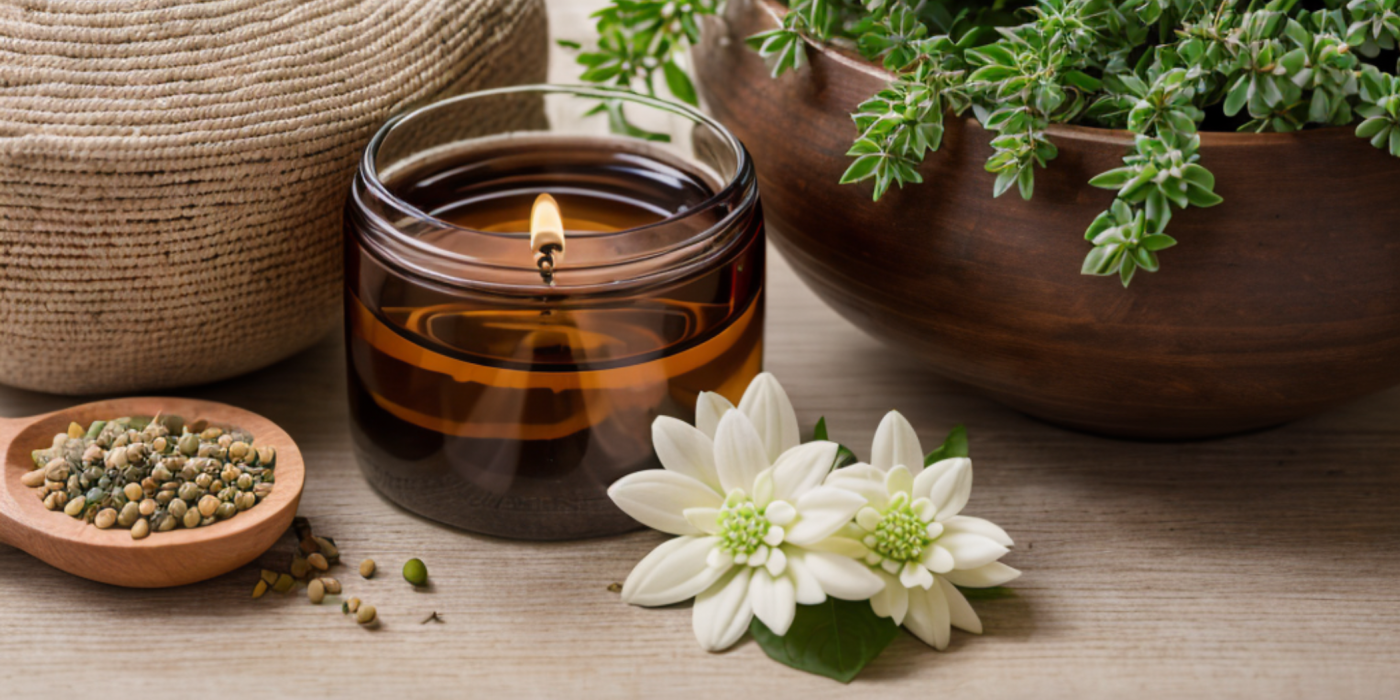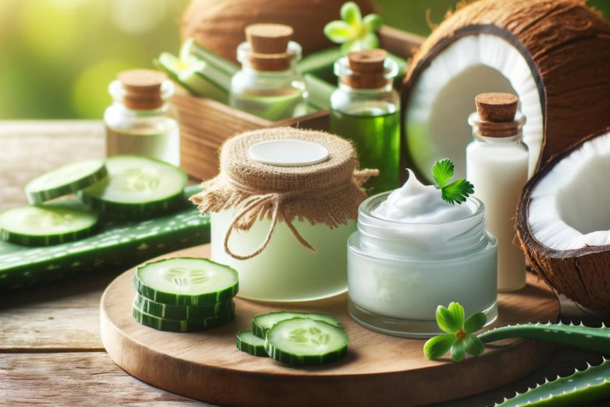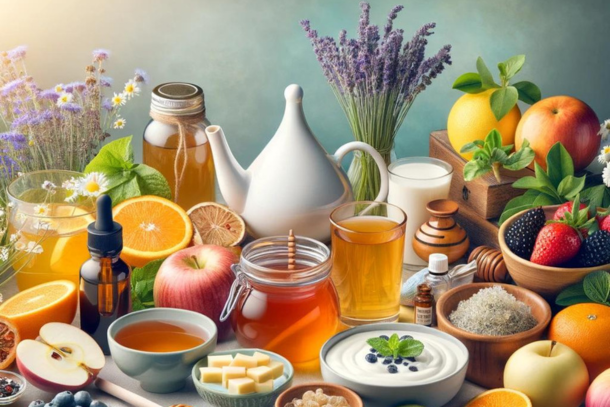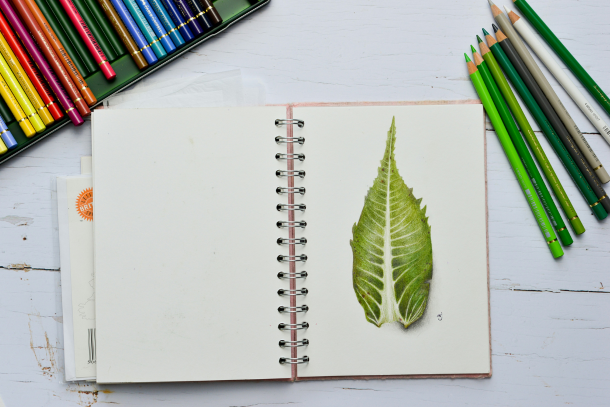Aromatic Therapy: Harnessing the Power of Aromas for Holistic Wellness

In today's rapidly evolving and often chaotic world, the power of nature provides a gentle touch of tranquillity and relief. Among such natural healers, Aromatic Therapy (AT) stands out for its holistic approach towards health and wellness.
Understanding Aromatic Therapy
Aromatic Therapy, more commonly referred to as Aromatherapy, is a holistic healing practice that harnesses the power of plant extracts and essential oils to promote physical and emotional well-being. It's a sensory experience that works on the principle that certain aromas, when inhaled or applied to the skin, can have therapeutic effects on our body and mind.
The Roots of Aromatic Therapy
The practice of AT has deep roots, tracing back to ancient civilisations, including the Egyptians, Chinese, Indians, Greeks, and Romans. They utilised aromatic plant components for religious rituals, beauty care, food preparation, and medical purposes. Fast forward to the late 20th century, when the term 'Aromatherapy' was coined by French chemist René-Maurice Gattefossé, the modern incarnation of AT began to take shape.
Aromatic Therapy in Today's World
In the current climate of relentless hustle and bustle, stress and anxiety have become unwelcome constants in many lives. This is where AT, with its non-invasive, natural, and soothing methodologies, can make a significant difference. As people seek alternatives to conventional medicine or as a complement to it, AT has gained prominence for its potential to reduce stress, alleviate anxiety, enhance mood, improve sleep, and provide a general sense of relaxation and peace. As we delve into the world of AT, it's fascinating to discover how such a simple act, like inhaling a specific scent, can be instrumental in cultivating our overall health and wellness.
Understanding the Basics of Aromatic Therapy
Fundamentals of Aromatic Therapy
Aromatic Therapy, also known as Aromatherapy, is a form of holistic healing that utilises the aromatic compounds derived from plants, primarily in the form of essential oils. These volatile plant extracts are believed to promote physical and emotional well-being. Through inhalation or application on the skin, these therapeutic scents are used to stimulate the olfactory system, affecting the limbic system, which in turn influences emotions, mood, memory, and learning.
The Vital Role of Essential Oils
Essential oils serve as the backbone of aromatic therapy. Extracted from various parts of plants - including flowers, leaves, bark, roots, and peels - these oils carry the "essence" of the plant's fragrance and therapeutic properties. Each oil has its unique composition and offers different benefits. For instance, lavender oil is known for its calming effects, while eucalyptus oil is often used for its decongestant properties.
There are several methods of essential oil extraction, including steam distillation, cold pressing, and solvent extraction. It's crucial to note that the quality of essential oils can vary greatly, depending on factors such as the plant's growing conditions, extraction method, and handling.
Scent Interaction in Aromatic Therapy
In the context of aromatic therapy, scents play a pivotal role. When inhaled, the aroma molecules travel up the nose to the olfactory receptors, which send signals directly to the brain's limbic system. This system is responsible for various functions, including emotion, behaviour, and memory. Therefore, different scents can evoke different emotional responses and behavioural changes, which is at the core of aromatic therapy.
Through an understanding of these basics, one can appreciate the intricacies of aromatic therapy and its potential for holistic healing.
The Science Behind Aromatic Therapy
In order to fully understand the benefits and potential of aromatic therapy, it's crucial to delve into the scientific mechanisms that underpin it. We shall explore the neurological and psychological impacts of scents, and the critical role of the olfactory system and look at current scientific research that supports the practice of aromatic therapy.
Neurological and Psychological Effects of Scents
Our sense of smell is extraordinarily powerful, and its impact extends far beyond mere recognition of pleasant or unpleasant odours. Scents have the ability to invoke memories, stimulate emotions, and even influence our behaviour. The reason for this lies in the direct connection between our olfactory system and areas of the brain involved in memory and emotion, namely the hippocampus and amygdala. Consequently, certain scents can trigger emotional responses or recall vivid memories, underlining the potent neurological and psychological effects they can exert.
The Role of the Olfactory System in Aromatic Therapy
The olfactory system plays a pivotal role in aromatic therapy. Upon inhaling an aroma, the olfactory receptors located in the nose transmit signals to the brain, specifically the limbic system - our emotional centre. Essential oils used in aromatic therapy can stimulate these receptors, eliciting various emotional and physiological responses. The ability to modulate mood, promote relaxation, and even provide relief from conditions such as anxiety or insomnia stems from this intricate interplay.
Current Scientific Research Supporting Aromatic Therapy
Current research corroborates the efficacy of aromatic therapy. Numerous studies have found that certain essential oils can aid in alleviating symptoms of anxiety, depression, and sleep disorders, amongst other conditions. Moreover, research suggests that the practice can contribute to improved concentration, enhanced mood, and even boosted immune function. It's clear from these scientific insights that aromatic therapy holds a robust basis in neuroscience and psychology, and its potential for promoting holistic wellness continues to be explored.
The Proven Benefits of Aromatic Therapy
Aromatic Therapy (AT), also known as Aromatherapy, boasts a myriad of health benefits that have been acknowledged for centuries. This article delves into the key advantages of AT, providing a comprehensive look at how essential oils can become a cornerstone of your wellness regime.
Stress Relief through Aromatic Therapy
One of the most celebrated benefits of AT is its impressive capacity for stress relief. The inhaling of specific essential oils such as lavender, bergamot, and chamomile can help to trigger a relaxation response in the brain, thereby mitigating the body's stress response.
A Case Study on Stress Relief
Consider the case of a 2016 study conducted at a hospital in the UK. It found that patients exposed to lavender essential oil showed significantly reduced perceptions of stress, demonstrating the potential of AT in a real-world, high-stress environment.
Anxiety Reduction and Sleep Improvement
Beyond stress relief, AT can play a significant role in reducing anxiety levels and improving sleep quality. Essential oils like ylang-ylang and jasmine have been observed to lower heart rate and blood pressure, promoting a sense of calm.
Testimonials on Sleep Improvement
In countless testimonials, individuals suffering from insomnia or poor sleep quality have reported notable improvements after incorporating AT into their bedtime routine. A diffuser with a few drops of essential oil, such as lavender or vetiver, can create a soothing environment conducive to a good night's sleep.
Mood Enhancement with Aromatic Therapy
Lastly, AT can work wonders in enhancing one's mood. Citrus oils, for instance, are renowned for their uplifting properties, infusing a sense of happiness and positivity.
In conclusion, the benefits of Aromatic Therapy range from stress relief and anxiety reduction to sleep improvement and mood enhancement. As research continues to unravel its full potential, AT stands as a promising and natural approach to holistic wellbeing.
Application of Aromatic Therapy
As the appreciation of aromatic therapy (AT) expands, more individuals are looking to incorporate it into their everyday routines for improved wellbeing. In this section, we shall discuss effective methods to utilise AT, best practices for using essential oils, and how AT is implemented in professional environments such as spas and therapy centres.
Incorporating AT Into Your Daily Routine
Incorporating AT into your daily life can be surprisingly simple. Many people find it beneficial to start their day with invigorating scents like citrus or peppermint. You can use an aroma diffuser to fill your space with these uplifting aromas as you begin your day. Similarly, at the end of the day, calming scents like lavender or chamomile can promote relaxation and better sleep.
Best Practices for Using Essential Oils
When using essential oils, quality is crucial. Always choose pure, natural oils and avoid synthetic or adulterated versions. Dilution is typically necessary as essential oils are highly concentrated. Use a carrier oil like almond or jojoba to dilute essential oils before applying to the skin. Furthermore, remember that each essential oil has its unique properties and benefits, so it's worth taking the time to learn and experiment with different oils.
Aromatic Therapy in Professional Settings
In professional settings such as spas and therapy centres, AT is often combined with other treatments to enhance their effects. For instance, in a massage therapy session, essential oils are used in conjunction with massage techniques to promote relaxation and relieve tension. Similarly, in a spa environment, aromatic therapies like aromatherapy steam sessions can provide deep relaxation and detoxification.
Through thoughtful application and mindful usage, aromatic therapy can become a potent tool in your self-care arsenal, promoting both physical and emotional wellbeing.
Risks and Precautions
While the therapeutic benefits of Aromatic Therapy (AT) can be highly beneficial, it's vital to understand that there are also potential risks and precautions to be mindful of.
Understanding the Risks
The therapeutic use of essential oils in AT is generally safe, but like any therapeutic treatment, there can be potential side effects. These may include allergic reactions, skin irritation, or even phototoxic reactions with certain oils when exposed to sunlight. Overuse or misuse of essential oils can also lead to nausea, headaches, or hormonal imbalances. Therefore, it's crucial to understand the correct usage and dosage before embarking on your AT journey.
Safety Measures and Precautions
Firstly, always perform a patch test before applying any new essential oil to your skin. Secondly, certain oils, like citrus-based ones, can increase your skin's sensitivity to the sun, and thus should be used with caution. Always follow the guidance provided by reputable sources or professionals in the field. It's also worth noting that some essential oils may not be suitable for pregnant women or people with specific health conditions. Therefore, if you fall into any of these categories, please consult with a healthcare professional prior to using AT.
Quality Matters
Lastly, the quality of the essential oils you use is of paramount importance. Synthetic or adulterated oils can be potentially harmful, and they do not provide the therapeutic benefits of pure, natural oils. Opt for high-quality, organic oils from trusted brands to ensure you're receiving the maximum benefits from your AT.
In conclusion, while AT has numerous advantages, it should be practised responsibly and safely. Always do your research and, where necessary, consult with professionals.
The Future of Aromatic Therapy
In an ever-evolving world where the spotlight is steadily shifting towards alternative and holistic healing methods, Aromatic Therapy (AT) is poised for significant expansion. The future of this fascinating field, deeply rooted in traditional medicine, presents a plethora of opportunities.
Emerging Trends in AT
Increasingly, we are witnessing a fusion of technology and AT. Devices such as smart diffusers are becoming more prevalent, allowing users to control the type and intensity of aromas remotely using mobile apps. Additionally, personalised AT, where essential oil blends are tailored to individual needs, is gaining traction.
Potential Future Research and Developments
The arena of AT is ripe for exploration, with several promising avenues for research. There is an increasing interest in understanding the impact of individual essential oils on specific health conditions. Furthermore, scientific investigation into the combined effect of AT and other therapies, such as massage or acupuncture, could provide a more comprehensive approach to wellness.
The Growing Global Market for AT
There's no denying the swelling interest in AT around the globe. As stress levels soar, more people are seeking natural, non-invasive ways to maintain mental and physical well-being. The AT market, already valued in the billions, is expected to see robust growth. A rising consumer preference for organic and natural products, coupled with an enhanced awareness of the health benefits of AT, is likely to propel this market further.
Undoubtedly, the future of Aromatic Therapy is brimming with potential. As research continues to unfold, our understanding of the power of aromas will only deepen, opening up new possibilities for holistic healing.
Embracing the Power of Aromatic Therapy
In the realm of holistic wellbeing, Aromatic Therapy (AT) holds a significant place. Its importance cannot be overstated, especially in a fast-paced world where the need for holistic healing practices that balance our physical, mental, and emotional health has become paramount.
The Role and Benefits of Aromatic Therapy
AT leverages the power of aromas, particularly from essential oils, to engage our olfactory system, tapping into neurological and psychological pathways that can promote stress relief, anxiety reduction, improved sleep, and mood enhancement. It acts as a gentle yet potent avenue for promoting overall wellness and instilling tranquillity in our lives.
The evidence-backed benefits of AT are manifold. From the alleviation of stress and anxiety to the promotion of a good night's sleep, and mood enhancement, AT holds the key to a vast array of potential health benefits. Beyond the individual level, AT is also becoming a valuable tool in professional settings, such as spas and therapy centres, broadening its scope and impact.
Encouragement to Explore Further
Despite the many benefits, AT remains an unexplored frontier for many. Therefore, we strongly encourage our readers to delve deeper into this fascinating field of holistic healing. Whether you are considering incorporating AT into your daily routine or you are a health professional interested in expanding your therapeutic offerings, AT has a wealth of potential to explore. Remember, the journey to wellness often requires exploring new paths, and AT might be the key to unlocking your holistic health potential.
In essence, Aromatic Therapy presents a world of benefits that extend beyond just physical wellbeing. It's about a more harmonious, balanced lifestyle. Embrace AT, and let the power of scent guide your wellness journey.
Credible Sources Informing the Essence of Aromatic Therapy
Our understanding of Aromatic Therapy has been enriched through a plethora of insightful and credible sources. We owe the depth of this article to the findings, knowledge, and wisdom enshrined within these materials.
Scientific and Academic Research
Amongst the treasures of understanding, we count numerous peer-reviewed scientific and academic research papers. Publications such as the Journal of Alternative and Complementary Medicine, the British Journal of Nursing, and the Journal of Clinical Aromatherapy provide rigorous, evidence-based analysis and findings which underpin the science of Aromatic Therapy.
Notable Researchers
Key researchers such as Dr. Robert Tisserand, a leading expert in the field of aromatherapy, and Jennifer Peace Rhind, a renowned aromatherapist and lecturer, have offered invaluable insights into the world of aromas and their healing potential.
Reputable Books and Online Resources
An array of reputable books on aromatherapy, such as 'Essential Oils: A Comprehensive Handbook for Aromatic Therapy' by Jennifer Peace Rhind and 'The Art of Aromatherapy' by Robert Tisserand have played an integral role in our exploration.
Online Resources
Furthermore, online platforms like Aromatherapy Associates London and the International Federation of Aromatherapists offer a wealth of digital resources. These include guides, research papers, articles, and discussion forums that foster a broader understanding of the field.
Historical and Cultural Texts
Lastly, we acknowledge the wisdom of historical and cultural texts. Centuries-old knowledge from various cultures globally, including ancient Chinese and Indian Ayurvedic texts, have greatly informed our perspective on Aromatic Therapy.
This mixture of modern research, insightful books, reputable online platforms, and age-old wisdom gives us a comprehensive and credible outlook on the potent field of Aromatic Therapy.
Embrace Aromatic Therapy: Join the Conversation & Stay Updated
Let's delve into our invitation for you to engage further with our aromatic community.
Sharing is Caring
Here at our blog, we believe that knowledge is for sharing, and what better way to promote the benefits of aromatic therapy than by letting others in on the secret? If you found this article helpful, enlightening, or simply enjoyed it, we encourage you to share it with your friends, family, and social networks.
By sharing, you're not only spreading awareness about the holistic benefits of aromatic therapy, but you're also fostering a community that values health and wellness. With the power of social media and word-of-mouth, we can enhance lives, one aroma at a time.
Let's Connect on Socials
Find us on Facebook, Twitter, Instagram, and LinkedIn. Don't forget to tag us when you share!
Stay Informed with Our Newsletter
Should you wish to dive deeper into the world of aromatic therapy and holistic wellness, we invite you to sign up for our newsletter. By subscribing, you'll receive monthly insights right into your inbox, featuring the latest trends, cutting-edge research, and practical tips on applying aromatic therapy in your everyday life.
Sign Up Today
Just click the "Subscribe" button below. We respect your privacy and promise not to flood your inbox.
By engaging with us, you're taking an active step towards a healthier, more balanced lifestyle. Thank you for joining our community – here's to a life enhanced by the therapeutic power of aromas!
Related to this article are the following:
I do hope you have enjoyed this article and hope that you will subscribe to my newsletter so you can get the latest information about all things naturally relaxing.
Stay in touch, join the Naturally Relaxing Newsletter
Newsletter Signup
Post Your Comments
or post as a guest
Be the first to comment.
Latest articles in Lifestyle

DIY Natural Beauty Treatments for Glowing Summer Skin

10 Natural Remedies to Combat Summer Allergies

How to Create a Relaxing Outdoor Space for Summer

Mindfulness Techniques to Reduce Stress in Your Daily Life

Hydration and Wellness: Natural Ways to Stay Hydrated in Summer






